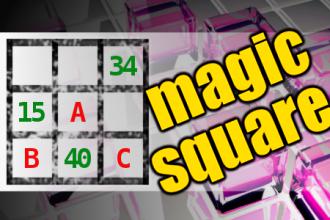MAGIC SQUARE: Calculate A*B-C
The aim is to place the some numbers from the list (8, 12, 15, 16, 27, 31, 33, 34, 37, 40) into the empty squares and squares marked with A, B an C. Sum of each row and column should be equal. All the numbers of the magic square must be different. Find values for A, B, and C. Solution is A*B-C.
One wish
A guy walking along the beach finds a bottle and picks it up.
A genie pops out and says, "Thanks for letting me out. For your kindness I will grant you one wish."
The guys says, "I've always wanted to go to Hawaii, but I can't because I'm afraid to fly and ships make me deathly sick. My wish is for you to build a road from here to Hawaii."
The genie says, "I'm sorry, but I don't think I can do that. Just think of all the work involved. Think of the huge pilings we'd need to hold up that highway and how deep they would have to be to reach the bottom of the ocean. And think of all the cement that would be needed. Plus, since it's such a long span, there would have to be gas stations and rest stops along the way. No, that's just too much to ask. Impossible."
The guy says, "Well, there is one thing I've always wanted to know. I'd like to be able to understand women...what makes them laugh and cry...you know, what makes them tick."
The genie thinks a second, then asks, "You want two lanes or four?'

